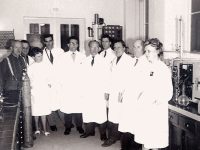
Let’s have another helping of scientific poetry, this time in the form of a steak. Incandescent embers illuminated the previous article in this section: sunlight trapped by a tree and encapsulated in the form of glucose by photosynthesis. The wood containing this glucose was first transformed into charcoal and then into embers, plant pyrotechnics in a combustion process that is a reversion to the original stage, photosynthesis in reverse.
Let us now turn our gaze to the beef steak that is starting to brown on the grill of our barbecue. Strange as it may seem, what will happen to that piece of meat once you eat it is closely related to the combustion process going on underneath it. It is virtually the same process, but orchestrated differently: just as charred glucose burns in the coals, your body’s own power plants burn the glucose in the steak. In fact, it is exactly the same glucose; in other words, they are different copies of molecules that originated in the same way and then took different paths. We can imagine two glucose molecules, newly photosynthesised twin sisters, each part of a twig. One of these tender shoots is chewed by a calf, while the other remains on the plant, growing and growing until it is transformed into a thick branch, which is then cut, turned into charcoal, and sold at the nearest supermarket. We already know the brilliant and poetic ending of the latter (see «The magic barbecue [part 1]» in issue 114 of Mètode).
The other glucose, the one that went into the calf’s guts, will have a slightly more troubled life, it will have more interesting stories to tell its granddaughters but, and here is the fascinating thing about it, its end will be almost identical, just as bright and poetic. Once in the bovine body, our protagonist will accumulate with other colleagues in a muscle, forming part of a macromolecule called glycogen. There it will remain tucked away, warm, but not safe from carnivores, who take advantage of the photosynthetic work of plants through herbivores, who act as intermediaries. We have no choice, because our physiology – and that of cows too – is incapable of synthesising such sugars.
The plant eats the sunlight, the cow eats the plant, and those of us who eat the cow end up with a piece of sunlight in our bellies. This is how we get to that steak which, by now, should be ready to pass through our digestive system. In addition to proteins, our cells are deeply interested in the glucose that now runs through our blood, because it is a magnificent source of energy: using it we make adenosine triphosphate (ATP), the energy molecule par excellence this side of the solar system. But how do you get ATP from substances like glucose? Quite simply: by setting it on fire, by burning the glucose in a combustion process which, as I have indicated, is entirely analogous to coal combustion.
The power plants in charge of that combustion are called mitochondria and they are running non-stop in the vast majority of your cells, combining the fuel – our protagonist – with oxygen and releasing CO2, water, and electromagnetic radiation in the form of heat; the reverse photosynthesis I was talking about earlier. Some of that energy goes into building ATP (that is a story for another time). Now focus on the energy released: you are a bright being; your heat, those 36–37 degrees Celsius in your body, are achieved by releasing the solar radiation trapped in the chemical bonds of glucose. Not only are we stardust, each of us carries sunlight within.




